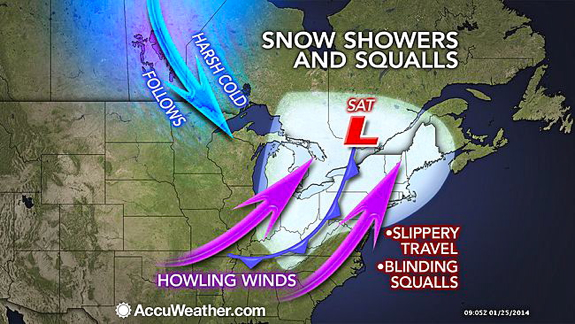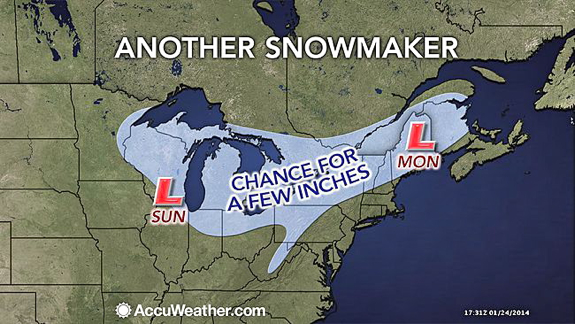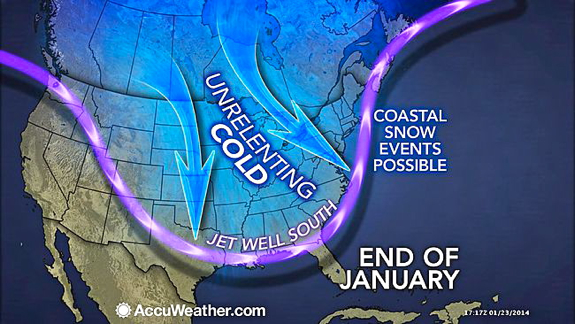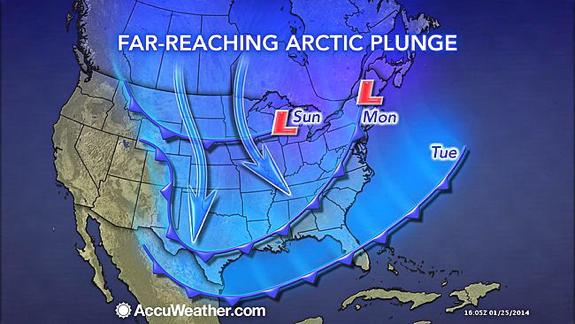Thursday, Jan. 23, 2014
![Winter Weather Super Bowl Football]() Snow is accumulated on the seats and on the field of MetLife Stadium as crews removed it ahead of Super Bowl XLVIII following a snow storm, Wednesday, Jan. 22, 2014, in East Rutherford, N.J. (AP Photo/Julio Cortez)
Snow is accumulated on the seats and on the field of MetLife Stadium as crews removed it ahead of Super Bowl XLVIII following a snow storm, Wednesday, Jan. 22, 2014, in East Rutherford, N.J. (AP Photo/Julio Cortez)
EAST RUTHERFORD, N.J. (AP) - The NFL and personnel at MetLife Stadium had a Super Bowl pop quiz on snow removal less than two weeks before the title game between the Denver Broncos and Seattle Seahawks.
The league and stadium officials decided to use a winter storm that dumped a foot or more of snow in the New York City metropolitan area Tuesday as somewhat of a dress rehearsal to see how quickly they could clean the 80,000-seat facility that will hold the first outdoor Super Bowl in cold weather.
NFL executive vice president Eric Grubman said Wednesday an 18-hour time limit was set for removing the snow from the stadium, surrounding parking lots and access roads in the Meadowlands sports complex, where the game will be played Feb. 2.
Grubman refused to speculate whether the storm that snarled roads, closed schools and had states of emergency in New Jersey, New York City and some surrounding areas would have caused the Super Bowl to be postponed. He said that would be a decision made by state authorities.
Grubman, however, said the league has several contingency plans for the game, including moving it up to Friday or Saturday, pushing it back to Monday or adjusting the scheduled start on Sunday deal with the weather. The game is scheduled to start at 6:25 p.m. EST.
"Based on the long-range forecast, all that I would even hazard to guess is that it is probably going to be cold. I doubt we are going to have an unusual warm spell," Grubman said at the news conference originally called to showcase how the stadium was preparing for the Super Bowl.
The snowstorm on Tuesday was a fortuitous coincidence for the cold-weather Super Bowl.
MetLife spokeswoman Nicole Fountain said the stadium and its contractors had 1,300 workers removing the 13 inches of snow that fell in and around the stadium. The crews started removal at around 8 a.m. and had sections of the stadium and most of the tarp-covered field cleared by noon.
During this past season, the crews removed six inches of wet, iced-packed snow in roughly 12 hours before a Seahawks-Giants game on Dec. 15, Ron VanDeVeen, the stadium's senior vice president of events said Wednesday. The snow being removed Wednesday was not as heavy, he said.
Grubman said the league is prepared to play the game even if there is still some snow in the stands.
"Games are played with snow all the time," he said. "It's not just MetLife Stadium. I think the crowd will be an exceptional crowd and they will enjoy the game. I don't think they will be fazed by a little bit of snow on their seats, if that's what comes to pass. We aim to not have that happen, but if it happens, it's sort of what happens in NFL stadiums all the time."
Grubman also displayed warm welcome kits that fans will receive entering the stadium on game day. Cushions hold the kit items which included ear and hand muffs, mittens, a hat, neck warmers, lip balm and other items.
"The warm welcome kit was designed to make fans comfortable," he said, "and to have those last-minute items that they may not think about."
Grubman also advised fans to dress in layers for the game. He said there will be warming areas in the stadium should anyone need them.
The storm that hit the area Tuesday stretched from Kentucky to New England.
"If you are going to have one, and you are going to have it 10 days out, we're going to make use of it," Grubman said of the storm. "The silver lining is we are running ourselves through a rigorous dress rehearsal."
Grubman said the league was gathering information from law enforcement authorities about how the emergency conditions might have affected the game had it been played Tuesday. The two groups will go over the information soon.
Whatever happens, the league is ready to deal with all scenarios, Grubman said.
"Some people will say perfection will be a nice little dusting of snow in the third quarter," Grubman said. "Other people will say perfection will be 40 degrees in early February with the sun shining until sundown at 5:35 or 5:45 or 6:20 on Sunday, the second.
"I think it is really up to the individual."
RELATED ON SKYE: 20 Photos of Monster Blizzards
![]()
Permalink | Email this | Linking Blogs | Comments















































